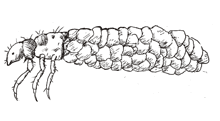
Overview
Just beneath the water's surface there is a multitude of life. In addition, the riparian ecosystem stretches out beyond the banks of Maryland's rivers and streams. When people think of the critters that live in the water, they most often think of fish, but that's not even half the story. Freshwater mussels, crayfish, and larval insects are often concealed in the rocks and mud, while snakes, lizards, salamanders, and frogs venture about near the stream in search of food and shelter.
Maryland's incredible variety in terrain, from the mountains to the sea, allow for trememdous biodiversity. This state is home to over 100 species of fish, over 20 salamanders, more than 10 types of turtles... You get the idea. Below you will find a quick survey of some of the creatures (and plants!) you can find in and around Maryland's freshwater streams.
Fish
There is an incredible variety of fish in Maryland's waters. From the northern cold water streams where brook trout search for a stonefly dinner, to the acidic, tea-stained Eastern Shore waters where the beautiful black banded sunfish lives, the variety of freshwater habitat in this state allows for a high level of diversity. However, the most populous fish in Maryland, the blacknose dace, thrives because of its tolerance of degraded streams. The American eel is also very tolerant, and is an amazing fish that lives in freshwater streams, but travels thousands of miles to the Sargasso Sea to spawn. The larvae then make the long trek back to their home waters to begin the cycle anew.
 For a guide to identifying the freshwater fish of Maryland, view our key (4 MB .pdf file)
For a guide to identifying the freshwater fish of Maryland, view our key (4 MB .pdf file)
Amphibians, Lizards, Turtles, and Snakes
For the rivers and streams of Maryland, life doesn't stop at the water's edge. Many species are stream dependent, and use our waters as a spawning area, drinking source, and a hunting ground. Small seasonal pools hold salamander eggs, which may grow to adults who patrol the edges of our waterways in search of food. Lizards and snakes are often found in the riparian area within several meters of the water, looking for aquatic insects and fish to eat. The Maryland Biological Stream Survey collects data on these creatures to determine the range of endangered species such as the hellbender salamander (the largest salamander in Maryland) as well as commonly found species such as the northern watersnake and the two-lined salamander.
 For a guide to Maryland's Herpetofauna, view our key (72 MB .pdf)
For a guide to Maryland's Herpetofauna, view our key (72 MB .pdf)
Plants
Many plants inhabit the riparian zone, or the land area immediately adjacent to a river or stream. These plants have a cooperative relationship with the water body. In exchange for essential water, vegetation provides important erosion control, filtration of nutrients and sediment, and temperature regulation. Land use changes can alter this landscape, lowering the quality of aquatic habitat. Trees that associate with rivers such as sycamore are extremely important to riparian life, even after they die. In-stream woody debris provide shelter and food to countless insects and fish. In addition, submerged aquatic plants such as curly pondweed also provide important cover and food for a variety of species.
Macroinvertebrates
Macroinvertebrates is a long name used to describe any animal large enough to be seen by the naked eye that lacks a backbone. The Maryland Biological Stream Survey divides this group into three smaller sections: Aquatic Insects, Crayfish, and Mussels. Each type contributes a great deal to the biodiversity of Maryland's waters. For a short introduction to the macroinvertebrates of Maryland.
 View this helpful fact sheet.
View this helpful fact sheet.
Crayfish

Crayfish, crawfish, crawdads, mudbugs. Whatever you call them, they are vital to a stream's ecosystem. They can be found under rocks and hidden in mud burrows on river banks. As voracious omnivores, they provide a vital link in aquatic food webs. They play an important role in processing leaves, stems, and other plant material that enters the stream. Crayfish also provide a valuable source of food to fishes, birds, raccoons, and other animals. Soft-shelled crayfish are the only food item eaten by adult queensnakes.
Aquatic Insects

Stoneflies, mayflies, and caddisflies are just a few of the many types of aquatic insects found in Maryland's rivers and streams. Several species spend most of their life under and around rocks and vegetation until emerging as terrestrial or flying adults - sometimes for just one day - to mate and die. Aquatic insects work to process a variety of organic plant and animal matter that pass through rivers and streams, such as leaves, stems, and detritus. They serve as a terrific food source for fish and other stream-dependent creatures such as lizards and salamanders.
Mussels

Freshwater mussels are a diverse group of bivalves that carry out important jobs in aquatic ecosystems, like filtering nutrients and sediment, and providing habitat and food to other animals. They have a unique reproductive cycle that needs a host, usually a fish, to help them complete the cycle.You can see it in action in this clip on YouTube. Learn more about this important bivalve in this  Fact Sheet.
Fact Sheet.